Relighting Our Railroad, Part 1
So when I started each step of building our raised-platform railroad, I had a plan for the construction. And I thought I had a plan for my building and accessory lighting, though much of that fell through as other things took precedence.
I did try SOME planning. For example, when I built my platforms, I drilled holes and ran wires from the places I thought my buildings would sit back into the control area. I tied the outside end of each wire into a knot so I'd be able to pull it up and wire it to my buildings when I had them in place.
But by the time I had the rocks, dirt, and plants in place, and the plants had established, I could no longer locate that end of the wire without major disruptions. Ooops. For recent endeavors, I've mostly run the wire around the outside of the shed, burying it in gravel or rocks to hide it.
Also, I used several of those little 12-volt power supplies that I picked up in second-hand shops, the "wall wart" kind. You're not supposed to use those outside, but I housed them in the shed, and they were fine.
On my old, 90'-long railroad, those little power supplies made sense, since the towns to be lit were as much as 40' apart, so a "distributed" system worked better than running low-voltage wire all those lengths. I hid my "wall warts" in weather-proof buildings and never had any problem with them.
But here, a couple high-capacity 12-volt power supplies - the kind that come with, say, Malibu sets - should do the job. Having six or seven separate little power supplies plugged into different places made troubleshooting a whole lot more complicated.
I have a 110 circuit running to the train shed, so that was a good start. It included a GFI and a separate outlet that the GFI controlled.
I had a heavy-duty six-plug surge protector plugged directly into the GFI. My garden train power supplies and the little stereo I use to play "background music" were plugged into that. But everything else was pretty "willy-nilly."
Issues With Timers
First of all I have to say that some of my "better" timers failed right before I moved, including those big expensive Intermatic ones. So I was more-or-less starting from scratch here.
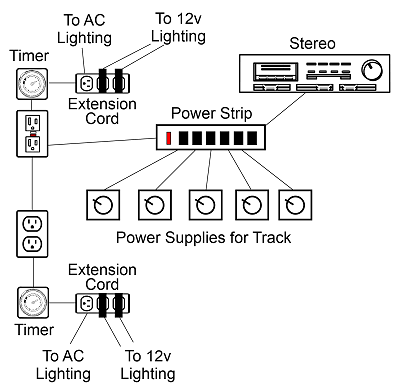 I wanted my building lights to come on at certain times (rather than waiting for dark, which doesn't always serve visitors who show up at twilight when building lighting is surprisingly effective). I wanted my building lights to come on at certain times (rather than waiting for dark, which doesn't always serve visitors who show up at twilight when building lighting is surprisingly effective).
So I bought timers that you could set to go off and on at different times by pushing and pulling little tabs. But because I hadn't planned well, some of those timers were in hard-to-reach corners. Every time we had a power outage, I would have to get back on my knees and reset them.
The picture to the right is an oversimplification to give you the general idea, without giving you a headache. In addition, it doesn't show the tangle of wiring that got worse every time I added or tried to troubleshoot a circuit. I believe the professional term is "spaghetti."
I've come to realize that the multiple "timer" circuits would be better served by a single photosensitive "timer" that turns things on when it gets dark, but which also has a knob that lets you turn everything on or off manually. So if I have visitors on a gloomy afternoon, I can turn the lighting on for effect.
Expanding and Correcting
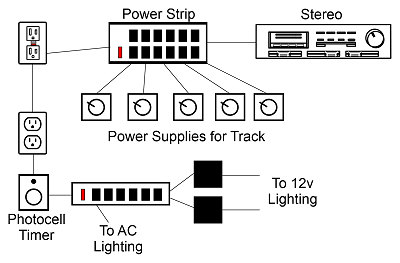 The photo to the right shows a simplified version of my current plan, already mostly achieved. (No, I won't show a photo, since there's still some cleaning up to do.) The photo to the right shows a simplified version of my current plan, already mostly achieved. (No, I won't show a photo, since there's still some cleaning up to do.)
Multiple clock-based timers have been replaced by one photo-cell timer, which will ordinarily come on at dark and keep the lights on for 2, 4, 6, or 8 hours, depending on how it is set.
But a big advantage for me is that it also has a bypass knob that lets me turn it on or off period. So I can turn all the lights on if folks come over on a gloomy day. And we have a lot of gloomy days in Ohio winters.
The "wall warts" will be replaced by 12v power supplies "borrowed" from garden lighting sets.
This also leaves two of the outlet plugs open in case I need to add something temporarily. Like a drill.
New Lines to Buildings
Yes, the part shown above required a lot of unplugging, moving things around and re-plugging.
But the "running lines to the buildings" part will be, frankly more complicated. I may be able to reuse some of the wires I've already run, but I want to run wires to places where I haven't had lighting before.
 The picture to the right shows a birds-eye view of our raised platform railroad. The picture to the right shows a birds-eye view of our raised platform railroad.
The sand-colored spaces represent the lower platforms, which are between 24" and 40" above the ground (which slopes). Though the upper levels (in the middle) have had lighting for a year or two now, only parts of the lower level have been connected.
The red circles are the parts where I had not run any wiring as of August, 2022.
The circle near the north corner of the railroad (top right) won't be so hard to connect, since I can run wire around the perimeter to get there (underneath the edge of the railroad, of course).
The other circle is a little tougher. To serve that one, I crawled on my belly underneath the platforms at that point. That was too much like work to repeat it often.
I ran not only wire, but new hoses for aeration, since I want to keep the aeration pump in the train shed this winter (up to now, it's been sitting on a piece of ground-rated lumber underneath one of the platforms).
 BTW, the wire I used was the black two-conductor 16ga wire that 12v systems like Malibu use, like this product on Amazon. I used this type on the other railroad and didn't notice failure or any conductivity loss to speak of. BTW, the wire I used was the black two-conductor 16ga wire that 12v systems like Malibu use, like this product on Amazon. I used this type on the other railroad and didn't notice failure or any conductivity loss to speak of.
 The rubber hose is the same kind that aquarium stores sell, but no one near me carries the lengths I needed, so I ordered this product from Amazon. The rubber hose is the same kind that aquarium stores sell, but no one near me carries the lengths I needed, so I ordered this product from Amazon.
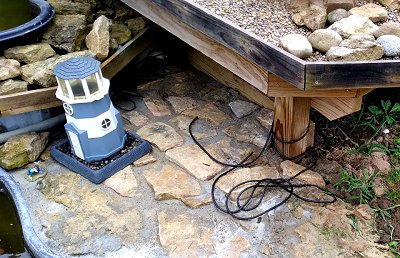 The photo to the right shows the new hose and wire that I ran underneath the platform to serve the new air pump and provide lighting to this corner of the railroad. The photo to the right shows the new hose and wire that I ran underneath the platform to serve the new air pump and provide lighting to this corner of the railroad.
I tied the ends of the wire and the hose to the post before I crawled under the platforms to run them back to the train shed, to make certain I had left everything long enough.
If you look closely at the "blowup," you'll see the old Penn-Plax "airPod" air pump, a bit of white back under the platform. It served for three years in this location, but only one side works now. Beause I am happy with it over all, I bought a direct replacement. Hopefully it will fare better inside the train shed. (BTW, I have tried several, and none of them lasts "forever," unless you get into professional units that cost quite a bit more and draw a lot more power.)
I actually ran two hoses, since I will be running two aerators in the pond this winter. As I've mentioned before, the big danger to goldfish in a frozen pond is the buildup of carbon dioxide from rotting organic material. Aeration forces the CO2 to find its way out.
The  Penn Plax" air pump that's supposedly rated for 100-gallon aquariums has two outputs and draws 8 watts. So it's much, much cheaper to run than when I used a heater to keep a hole open in the ice. The night light I use as a "candle in the window" of the train shed draws more juice. Penn Plax" air pump that's supposedly rated for 100-gallon aquariums has two outputs and draws 8 watts. So it's much, much cheaper to run than when I used a heater to keep a hole open in the ice. The night light I use as a "candle in the window" of the train shed draws more juice.
Again, the first one lasted three years and it was much more exposed to the weather than this one will be. I'll let you know if it fails prematurely.
Keep in Touch
If you're headed toward or past Springfield, Ohio, please let me know, and I'll see if we can work out a quick visit.
Finally, please let us know about your ongoing projects. Ask questions, send corrections, suggest article ideas, send photos, whatever you think will help you or your fellow railroaders. In the meantime, enjoy your trains, and especially enjoy any time you have with your family in the coming weeks,
Paul Race
FamilyGardenTrains.com
Return to Family Garden Trains' Home Page - The home page with links to all the other stuff, including design guidelines, construction techniques, structure tips, free graphics, and more.
 Proceed to "Relighting Our Railroad, Part 2" - Adding new wiring and lighting for several more buildings, replacing the aeration pump and its LED bubblers. Proceed to "Relighting Our Railroad, Part 2" - Adding new wiring and lighting for several more buildings, replacing the aeration pump and its LED bubblers.
Click on the photo to see our status as of mid-September, 2022
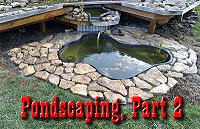 Return to "Pondscaping, Part 2" - Circling the rest ot the pond with stones, more comments about using sand mix and related topics. Return to "Pondscaping, Part 2" - Circling the rest ot the pond with stones, more comments about using sand mix and related topics.
Click on the photo to see our status as of mid-July, 2022.
 Return to "Pondscaping, Part 1" - In addition to a lot of spring maintenance I didn't have the heart to report, I also attacked a growing problem - erosion around our pond liner that looked bad and allowed excess weed growth. While I was evaluating alternatives, a garden railroading friend offered me a pile of rocks. So installing a rock border around the pond seemed like the best path. Return to "Pondscaping, Part 1" - In addition to a lot of spring maintenance I didn't have the heart to report, I also attacked a growing problem - erosion around our pond liner that looked bad and allowed excess weed growth. While I was evaluating alternatives, a garden railroading friend offered me a pile of rocks. So installing a rock border around the pond seemed like the best path.
Click on the photo to see our status as of early July, 2022.
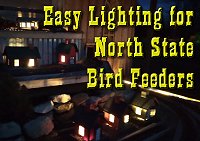 Return to "Easy Lighting for North States Bird Feeders" - After I put my model buildings away for the winter, I brought out the North States bird feeders I use to keep my railroad from looking naked all winter long. Since I had wired several sections of my railroad for lighting, I went ahead and put lighting in my bird feeders as well. Return to "Easy Lighting for North States Bird Feeders" - After I put my model buildings away for the winter, I brought out the North States bird feeders I use to keep my railroad from looking naked all winter long. Since I had wired several sections of my railroad for lighting, I went ahead and put lighting in my bird feeders as well.
Click on the photo to see our status as of December, 2021.
 Return to "Easy Lighting for North States Bird Feeders" - After I put my model buildings away for the winter, I brought out the North States bird feeders I use to keep my railroad from looking naked all winter long. Since I had wired several sections of my railroad for lighting, I went ahead and put lighting in my bird feeders as well. Return to "Easy Lighting for North States Bird Feeders" - After I put my model buildings away for the winter, I brought out the North States bird feeders I use to keep my railroad from looking naked all winter long. Since I had wired several sections of my railroad for lighting, I went ahead and put lighting in my bird feeders as well.
Click on the photo to see our status as of December, 2021.
 Return to "Preparing for 2021's Christmas Train Day." - In preparation for our annual Christmas-themed open railway, I ran lighting to some of our buildings, installed rope lighting on one section, and chose appropriate rolling stock. I also lit a bunch of our dwarf conifers and ran colored light strands that would brighten up our waterfall after dark. Return to "Preparing for 2021's Christmas Train Day." - In preparation for our annual Christmas-themed open railway, I ran lighting to some of our buildings, installed rope lighting on one section, and chose appropriate rolling stock. I also lit a bunch of our dwarf conifers and ran colored light strands that would brighten up our waterfall after dark.
Click on the photo to see our status as of early November, 2021.
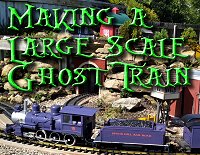 Return to "Making a Large Scale Ghost Train" - In preparation for an October open railway, I repainted and relabeled decrepit Bachmann Big Hauler pieces to create a one-of-a-kind Halloween train. Materials included purple spray paint and vinyl lettering I created on my Cricut. I added "ghost" passengers made from cheap Asian seated figures painted with glow-in-the-dark paint. Return to "Making a Large Scale Ghost Train" - In preparation for an October open railway, I repainted and relabeled decrepit Bachmann Big Hauler pieces to create a one-of-a-kind Halloween train. Materials included purple spray paint and vinyl lettering I created on my Cricut. I added "ghost" passengers made from cheap Asian seated figures painted with glow-in-the-dark paint.
Click on the photo to see our status as of mid-October, 2021.
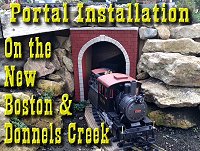 Return to "Portal Installation on the New Boston and Donnels Creek." . We shimmed out the frames for the tunnel entrances to make them more vertical, installed I.S.L.E. portals we had painted previously, and stacked stones around them to camouflage the wooden parts. There's a bit more work to do, but its a big improvement over black holes at each end of the tunnel Return to "Portal Installation on the New Boston and Donnels Creek." . We shimmed out the frames for the tunnel entrances to make them more vertical, installed I.S.L.E. portals we had painted previously, and stacked stones around them to camouflage the wooden parts. There's a bit more work to do, but its a big improvement over black holes at each end of the tunnel
Click on the picture to see our status as of early October, 2021.
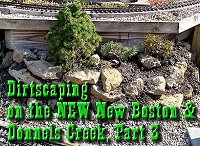 Return to "Dirtscaping on the New Boston and Donnels Creek, Part 3" - Raising 'mini-mountains' near the new tunnels to make them seem more blended into the dirtscape. Lots of rocks moved, and more trees trimmed and planted. Also, we moved our towns into position in preparation for a club meeting at our home. Return to "Dirtscaping on the New Boston and Donnels Creek, Part 3" - Raising 'mini-mountains' near the new tunnels to make them seem more blended into the dirtscape. Lots of rocks moved, and more trees trimmed and planted. Also, we moved our towns into position in preparation for a club meeting at our home.
Click on the photo to see our status as of mid-August, 2021.
 Return to "Tunnel Framing on the New Boston and Donnels Creek, Part 2" - Adding rocks, dirt, and plants to the new tunnel structures. Because I wanted to transplant dwarf and miniature trees to the new "mountains," I had to move a substantial amount of rocks and dirt. But I feel the result will be well worth it, once the groundcovers fill in. Return to "Tunnel Framing on the New Boston and Donnels Creek, Part 2" - Adding rocks, dirt, and plants to the new tunnel structures. Because I wanted to transplant dwarf and miniature trees to the new "mountains," I had to move a substantial amount of rocks and dirt. But I feel the result will be well worth it, once the groundcovers fill in.
Click on the photo to see our status as of late July, 2021.
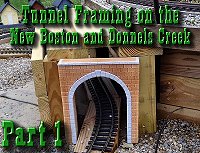 Return to "Tunnel Framing on the New Boston and Donnels Creek, Part 1." We planned and built two wooden boxes that would become the framework for two short tunnels on our raised platform railroad. That effort was made a little more complicated by the fact it was a "retrofit." I hadn't planned for them at first, so getting them in place took some finangling. Return to "Tunnel Framing on the New Boston and Donnels Creek, Part 1." We planned and built two wooden boxes that would become the framework for two short tunnels on our raised platform railroad. That effort was made a little more complicated by the fact it was a "retrofit." I hadn't planned for them at first, so getting them in place took some finangling.
Click on the picture to see our status as of mid-July, 2021.
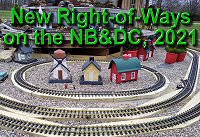 Return to "New Right-of-Ways on the New Boston and Donnels Creek RR" - Adding a loop based on 10'-diameter curves. Includes cutting and installing 2x6 roadbed, bridging the waterfall, and cutting a third passage through the train shed, as well as installing roadbed for two smaller loops. Return to "New Right-of-Ways on the New Boston and Donnels Creek RR" - Adding a loop based on 10'-diameter curves. Includes cutting and installing 2x6 roadbed, bridging the waterfall, and cutting a third passage through the train shed, as well as installing roadbed for two smaller loops.
Click on the picture to see our status as of late March, 2021.
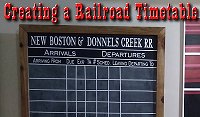 Return to "Creating a Railroad Timetable" - No train station would be complete without a timetable showing arrivals and departures (as well as expected arrivals and departures). We made one with a big piece of underlayment, framed it with scrap lumber, cut lettering for it with a craftcutter, and lined it with striping tape. This one is hinged to a shallow shelving unit that is holding the dvds we sometimes watch while working on projects in our workshop. Return to "Creating a Railroad Timetable" - No train station would be complete without a timetable showing arrivals and departures (as well as expected arrivals and departures). We made one with a big piece of underlayment, framed it with scrap lumber, cut lettering for it with a craftcutter, and lined it with striping tape. This one is hinged to a shallow shelving unit that is holding the dvds we sometimes watch while working on projects in our workshop.
Click on the picture to see our status as of January, 2021.
 Return to "Christmas Preparations and Operations 2020" - A series of families were going to visit during the holiday season (masked and distanced, of course), so we just had to do a little Christmas decorating, and get as many trains running as possible for the kids. This included laying temporary ROWs on the new platform and setting up two Lionel RTP trains for kids to run. Return to "Christmas Preparations and Operations 2020" - A series of families were going to visit during the holiday season (masked and distanced, of course), so we just had to do a little Christmas decorating, and get as many trains running as possible for the kids. This included laying temporary ROWs on the new platform and setting up two Lionel RTP trains for kids to run.
 Return to "Garage to Train Station, Part 2" - continuing to fix up one end of my garage to resemble a Victorian train station interior. I used a digital projector to outline vintage coach details for my windowframes. Then I painted the backgrounds, attached the windowframes, and installed them on the wall. A repro Regulator clock and other details are added. Return to "Garage to Train Station, Part 2" - continuing to fix up one end of my garage to resemble a Victorian train station interior. I used a digital projector to outline vintage coach details for my windowframes. Then I painted the backgrounds, attached the windowframes, and installed them on the wall. A repro Regulator clock and other details are added.
Click on the picture to see our status as of late December, 2020.
 Return to "Garage to Train Station, Part 1" - fixing up one end of my garage to resemble a Victorian train station interior. The initial steps included demolition, patching the ceiling and walls, moving electrical outlets, adding wainscotting and baseboard, and planning for windowframes with painted backgrounds. Return to "Garage to Train Station, Part 1" - fixing up one end of my garage to resemble a Victorian train station interior. The initial steps included demolition, patching the ceiling and walls, moving electrical outlets, adding wainscotting and baseboard, and planning for windowframes with painted backgrounds.
Click on the picture to see our status as of early December, 2020.
 Return to "Westward Expansion, 2020, Part 3" - Thanks to a spate of unusually warm weather in early November, I was able to get the new platform finished, lined with vinyl, and bordered with trim boards to keep the dirt and gravel in place. Return to "Westward Expansion, 2020, Part 3" - Thanks to a spate of unusually warm weather in early November, I was able to get the new platform finished, lined with vinyl, and bordered with trim boards to keep the dirt and gravel in place.
The next "permanent" improvements will wait for now. In the meantime, we will set out buildings and a temporary loop or to entertain visitors between now and Christmas.
Click on the picture to see our status as of mid-November, 2020.
 Return to "Westward Expansion, 2020, Part 2" - We had to be careful leveling the last joists so the frame, decking, and right-of-way would be as level as possible. Fortunately we were able to get enough lumber to get a good start on the frame. Return to "Westward Expansion, 2020, Part 2" - We had to be careful leveling the last joists so the frame, decking, and right-of-way would be as level as possible. Fortunately we were able to get enough lumber to get a good start on the frame.
We also added one last tweak to the frame design to make it easier to extend this platform to its originally planned size, if and when we get a chance to do so.
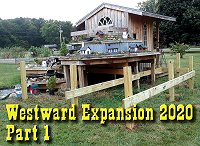 Return to "Westward Expansion, 2020, Part 1" - With a lumber shortage and warm weather running out, we revised our plans for the next addition, bought what decent lumber we could find, dug holes, installed posts, and attached joists. Return to "Westward Expansion, 2020, Part 1" - With a lumber shortage and warm weather running out, we revised our plans for the next addition, bought what decent lumber we could find, dug holes, installed posts, and attached joists.
We were hoping to get the lumber we need to finish the platform before cold weather set in. Click on the link to see our status as of late September, 2020.
 Return to "Train Storage Solutions, 2020" - Using periods of cold weather to get things sorted in the garage, including shelf building and tips for schlepping trains from storage to the tracks. Return to "Train Storage Solutions, 2020" - Using periods of cold weather to get things sorted in the garage, including shelf building and tips for schlepping trains from storage to the tracks.
Click on the following link to see our status as of late January, 2020.
https://familygardentrains.com/newbost/20_1_19_shelves/shelves.htm
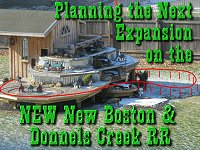 Return to "Expansion Planning, 2020" - Three years after starting a garden railroad in our new home, we are trying to figure out the best way to finish the last loop of our raised platform railroad. How to make room for 10'-diameter curves and more towns and industries, but still keeping things manageable requires some thinking and rethinking. Return to "Expansion Planning, 2020" - Three years after starting a garden railroad in our new home, we are trying to figure out the best way to finish the last loop of our raised platform railroad. How to make room for 10'-diameter curves and more towns and industries, but still keeping things manageable requires some thinking and rethinking.
Click on the photo to see the options we were reviewing for the next and last expansion.
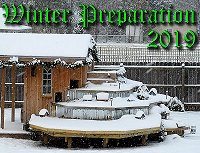 Return to "Winter Preparation, 2019" - After the big open railroad event, we try to prepare the railroad for the cold months, including populating the railroad with North States bird feeders so it doesn't look empty, adding an air pump and bubblers to the pond, and more. Return to "Winter Preparation, 2019" - After the big open railroad event, we try to prepare the railroad for the cold months, including populating the railroad with North States bird feeders so it doesn't look empty, adding an air pump and bubblers to the pond, and more.
Click on the following link to see our status as of early December, 2019.
https://familygardentrains.com/newbost/19_11_24_winter_prep/19_11_24_winter_prep.htm
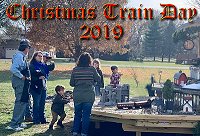 Return to "Christmas Train Day, 2019" - Three years after starting a garden railroad in our new home, we host another Christmas-themed open railroad, giving many families a jump start on Christmas celebrations and sharing the experience of running trains with lots of kids. Return to "Christmas Train Day, 2019" - Three years after starting a garden railroad in our new home, we host another Christmas-themed open railroad, giving many families a jump start on Christmas celebrations and sharing the experience of running trains with lots of kids.
Click on the photo to see a brief record of our busiest weekend in November, 2019.
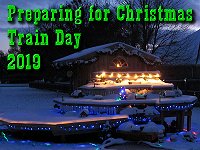 Return to "Preparing for Christmas Train Day 2019" - Wrapping up construction projects for 2019 and getting ready for our annual Christmas-themed open railroad. Includes new lighting and other features, providing a temporary home for a Hogwarts Express train, weather issues, and more. Click to go to article. Return to "Preparing for Christmas Train Day 2019" - Wrapping up construction projects for 2019 and getting ready for our annual Christmas-themed open railroad. Includes new lighting and other features, providing a temporary home for a Hogwarts Express train, weather issues, and more. Click to go to article.
Click on the following link to see our progress of mid-November, 2019.
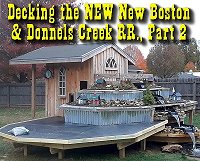 Return to Decking the NEW New Boston and Donnels Creek Part 2 - Getting the next part of the railroad ready to install trains. Includes installing 2"x6" decking, vinyl sheeting, edges to hold back the gravel, and corrugated steel panels. It's not done, but it will give us another place to set up trains for our next Christmas-themed open railroad. Return to Decking the NEW New Boston and Donnels Creek Part 2 - Getting the next part of the railroad ready to install trains. Includes installing 2"x6" decking, vinyl sheeting, edges to hold back the gravel, and corrugated steel panels. It's not done, but it will give us another place to set up trains for our next Christmas-themed open railroad.
Click on the photo to see our status as of late October, 2019.
 Return to "Framing the NEW New Boston and Donnels Creek RR - Part 7" - Installing posts, joists, framing, and decking for the eastern expansion of the NEW New Boston and Donnels Creek. Although this installation was complicated by having to fit into an existing framework, the methods used could work for any raised-platform railroad. Return to "Framing the NEW New Boston and Donnels Creek RR - Part 7" - Installing posts, joists, framing, and decking for the eastern expansion of the NEW New Boston and Donnels Creek. Although this installation was complicated by having to fit into an existing framework, the methods used could work for any raised-platform railroad.
Click on the following link to see our progress of early October, 2019.
 Return to "Planning the NEW New Boston and Donnels Creek RR - Part 5" - Once the major components of the water feature were installed and tested, we decided to add one more bit of railroad proper before our "Christmas Train Day," this November. The addition, about 5'x11', will allow us to put a small train and some scenery closer to eye level for youngsters. Eventually it will be part of the larger plan that will allow us to run our bigger cars and locomotives. Return to "Planning the NEW New Boston and Donnels Creek RR - Part 5" - Once the major components of the water feature were installed and tested, we decided to add one more bit of railroad proper before our "Christmas Train Day," this November. The addition, about 5'x11', will allow us to put a small train and some scenery closer to eye level for youngsters. Eventually it will be part of the larger plan that will allow us to run our bigger cars and locomotives.
Click on the photo to see our plans for the next addition, as of late September, 2019.
 Return to Waterscaping Part 4. - Installing the last connecting pool, so the whole planned waterfall is complete except for dirtscaping and planting. Return to Waterscaping Part 4. - Installing the last connecting pool, so the whole planned waterfall is complete except for dirtscaping and planting.
The process included checking the pump, extending the hoses, rescuing toads, building the platform, trimming the platform, testing the pool's location, etc.
Click the photo to go to the article.
 Return to "Waterscaping, Part 3" - After seven months of crazy long work hours, I finally got some free time to continue working on the railroad. Weather permitting, I often worked all the live-long day. This article describes installing two posts that will eventually support the last connecting pool, then digging the big hole for the in-ground pond, complicated by a three-month drought that turned the ground to concrete. Return to "Waterscaping, Part 3" - After seven months of crazy long work hours, I finally got some free time to continue working on the railroad. Weather permitting, I often worked all the live-long day. This article describes installing two posts that will eventually support the last connecting pool, then digging the big hole for the in-ground pond, complicated by a three-month drought that turned the ground to concrete.
Click on the photo to see our progress as of mid-September, 2019.
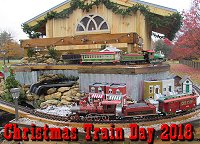 Return to Christmas Train Day, 2018 - After two years without our traditional Christmas Train Day (something we did from 2008 through 2015), we were anxious to get started again, even without a huge right of way to show off. The kids' trains, the extra Thomas railroad, the popcorn popper and two Bachmann Christmas trains got a big workout. And the visiting kids all loved it! Return to Christmas Train Day, 2018 - After two years without our traditional Christmas Train Day (something we did from 2008 through 2015), we were anxious to get started again, even without a huge right of way to show off. The kids' trains, the extra Thomas railroad, the popcorn popper and two Bachmann Christmas trains got a big workout. And the visiting kids all loved it!
Click on the photo to see a lot of last-minute preparations and some photos of the November 10, 2018 event itself.
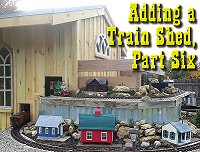 Return to "Adding a Train Shed Part 6" - Installing the board and batten siding on our train shed, installing the windows, installing the trim, testing the "tunnel entrances," and more. Return to "Adding a Train Shed Part 6" - Installing the board and batten siding on our train shed, installing the windows, installing the trim, testing the "tunnel entrances," and more.
By the way, going over lumber receipts in early 2019, I couldn't believe I was still siding the train shed in late October, and managed to have an open railroad in mid-November. It is a little crazy how fast things can go together if you have a deadline and a lot of gift cards.
Click on the photo to see our progress as of late October, 2018.
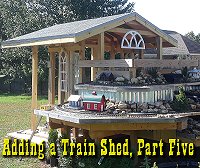 Return to "Adding a Train Shed Part 5" - Planning the doors, walls, and windows of our garden train shed. Return to "Adding a Train Shed Part 5" - Planning the doors, walls, and windows of our garden train shed.
Includes choosing the siding and windows, installing the door, painting the windowframes, and adding crosspieces to support the vertical siding boards.
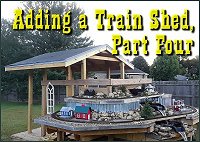 Return to "Adding a Train Shed Part 4" - Choosing and installing underlayment and drip edge to protect the sheathing until I can get the final roof installed. Return to "Adding a Train Shed Part 4" - Choosing and installing underlayment and drip edge to protect the sheathing until I can get the final roof installed.
Now the roof is waterproof enough to get us through the next couple of months at least, maybe more.
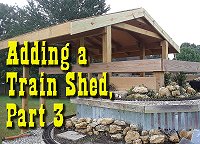 Return to "Adding a Train Shed Part 3" - Adding fascia, sheathing, and end trim to the in-progress train shed. Return to "Adding a Train Shed Part 3" - Adding fascia, sheathing, and end trim to the in-progress train shed.
I thought about bringing in helpers for this part, but a reader commented on how helpful it was to see how one person could do this sort of thing by himself, so I just kept plugging away.
Click on the photo to see our progress as of September 13, 2018
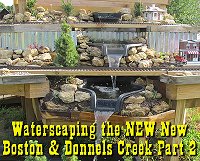 Return to "Waterscaping Part 2" - Getting this year's waterscaping project done (for now at least). Installing and dirtscaping the third level of the waterfall. Installing pump and filter, adding an extra container and modifying the ones we already had installed to keep the water running smoothly. And lots of other tweaking. Includes tips about introducing fish and plants, as well as other information about water features in general that you may find helpful. Return to "Waterscaping Part 2" - Getting this year's waterscaping project done (for now at least). Installing and dirtscaping the third level of the waterfall. Installing pump and filter, adding an extra container and modifying the ones we already had installed to keep the water running smoothly. And lots of other tweaking. Includes tips about introducing fish and plants, as well as other information about water features in general that you may find helpful.
Click on the photo to see our status as of August 5, 2018.
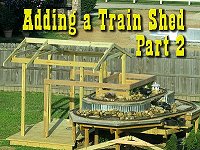 Return to "Adding a Train Shed Part 2" - Adding rafters to the frame of the in-progress train shed. Now it's starting to look like it might actually be a structure and not just a crazy collection of posts. Return to "Adding a Train Shed Part 2" - Adding rafters to the frame of the in-progress train shed. Now it's starting to look like it might actually be a structure and not just a crazy collection of posts.
The way we got the rafters and ridge board up wouldn't work for everybody, but it worked for us, and hopefully will help other folks to "think outside the box" - literally in this case.
Click on the photo to see our progress as of July 14, 2018.
 Return to "Adding a Train Shed Part 1" - What started out as a simple addition of a deck to stand on when putting trains on the track got a little more ambitious when I realized that JUST installing the deck this year would require more work next year. So we framed out what we planned to be a train shed attached to the railroad. If it ever gets finished, I can easily put trains on the track at a moment's notice instead of schlepping them out from the garage. Return to "Adding a Train Shed Part 1" - What started out as a simple addition of a deck to stand on when putting trains on the track got a little more ambitious when I realized that JUST installing the deck this year would require more work next year. So we framed out what we planned to be a train shed attached to the railroad. If it ever gets finished, I can easily put trains on the track at a moment's notice instead of schlepping them out from the garage.
Click on the photo to see our status as of July 9, 2018.
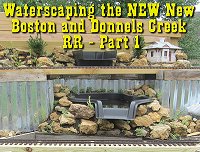 Return to "Waterscaping the NEW New Boston and Donnels Creek Part 1," our article on getting the top two layers of the waterfall on solid footing and getting the third layer framed. After we finish decking and dirtscaping the third layer, we will probably add a washbasin or something for the water to flow into, then add a pump to get the waterfall flowing. No big pond until next year at least - too many other projects. Return to "Waterscaping the NEW New Boston and Donnels Creek Part 1," our article on getting the top two layers of the waterfall on solid footing and getting the third layer framed. After we finish decking and dirtscaping the third layer, we will probably add a washbasin or something for the water to flow into, then add a pump to get the waterfall flowing. No big pond until next year at least - too many other projects.
Click on the photo to see our progress as of June 13, 2018.
 Return to "Dirtscaping the NEW New Boston and Donnels Creek RR, Part 2. - Adding barriers to keep the rocks, dirt, and plants where they're supposed to go, placing platforms and running wiring for buildings, adding rocks, dirt, and plants to the upper level of the railroad. Return to "Dirtscaping the NEW New Boston and Donnels Creek RR, Part 2. - Adding barriers to keep the rocks, dirt, and plants where they're supposed to go, placing platforms and running wiring for buildings, adding rocks, dirt, and plants to the upper level of the railroad.
Click on the photo to see our status as of June 1, 2018.
 Return to "Adding Raised Roadbed to the NEW New Boston and Donnels Creek, Part 2" - Trimming the corners off the roadbed on the upper layer and cutting the pieces that will support the curves on the middle layer. We need to get the upper two tiers of the pond installed before we totally complete this step, so the article doesn't quite show the finished product. You'll see it later as part of other articles. Return to "Adding Raised Roadbed to the NEW New Boston and Donnels Creek, Part 2" - Trimming the corners off the roadbed on the upper layer and cutting the pieces that will support the curves on the middle layer. We need to get the upper two tiers of the pond installed before we totally complete this step, so the article doesn't quite show the finished product. You'll see it later as part of other articles.
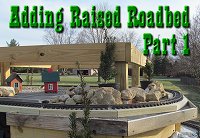 Return to "Adding Raised Roadbed to the NEW New Boston and Donnels Creek RR, Part 1" - Sorting out our priorities for the spring and summer of 2018. There a lot of little chores we really should get done before we start on the next big addition. Click to see our plans as of February 27, 2018. Return to "Adding Raised Roadbed to the NEW New Boston and Donnels Creek RR, Part 1" - Sorting out our priorities for the spring and summer of 2018. There a lot of little chores we really should get done before we start on the next big addition. Click to see our plans as of February 27, 2018.
Click on the photo to see our status as of February 20, 2018
 Return to "2018: Springing into Spring on the NEW New Boston & Donnels Creek RR." - Sorting out our priorities for the spring and summer of 2018. There a lot of little chores we really should get done before we start on the next big addition. Click to see our plans as of February 27, 2018. Return to "2018: Springing into Spring on the NEW New Boston & Donnels Creek RR." - Sorting out our priorities for the spring and summer of 2018. There a lot of little chores we really should get done before we start on the next big addition. Click to see our plans as of February 27, 2018.
Click on the photo to see our status as of February 20, 2018
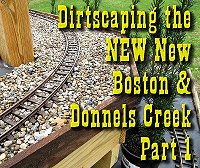 Return to "Dirtscaping the NEW New Boston and Donnels Creek RR, Part 1. - Putting edging around the existing "layers" of the new railroad, and beginning to add gravel and rocks. There were a few test runs, but we got stopped early by bad weather before we could dump the rest of the rocks, gravel, and dirt, much less plant the plants we hoped to get in before snowfall. Return to "Dirtscaping the NEW New Boston and Donnels Creek RR, Part 1. - Putting edging around the existing "layers" of the new railroad, and beginning to add gravel and rocks. There were a few test runs, but we got stopped early by bad weather before we could dump the rest of the rocks, gravel, and dirt, much less plant the plants we hoped to get in before snowfall.
Click on the photo to see our status as of November 21, 2017
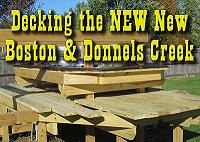 Return to "Decking the NEW New Boston and Donnels Creek RR - Decking the 'middle layer' of our proposed three-tier outdoor railroad. Prepping more track, laying out track and decking to make certain we have measurements correct, installing most of the remaining decking for this layer. Return to "Decking the NEW New Boston and Donnels Creek RR - Decking the 'middle layer' of our proposed three-tier outdoor railroad. Prepping more track, laying out track and decking to make certain we have measurements correct, installing most of the remaining decking for this layer.
Click on the photo to see our status as of October 25, 2017
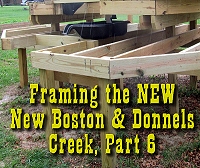 Return to "Framing the NEW New Boston and Donnels Creek RR, Part 6" - Modifying and finishing the framing on the second layer, cantilevering, using R3 track versus all other pre-curved track formats, finalizing the track plan, why painting the track makes old and new track blend better, and more. This will be the last bit of "framing" in 2017, and it worked out well, considering. Return to "Framing the NEW New Boston and Donnels Creek RR, Part 6" - Modifying and finishing the framing on the second layer, cantilevering, using R3 track versus all other pre-curved track formats, finalizing the track plan, why painting the track makes old and new track blend better, and more. This will be the last bit of "framing" in 2017, and it worked out well, considering.
Click on the photo to see our status as of October 15, 2017
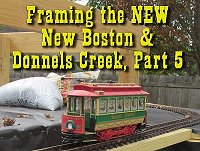 Return to "Framing the NEW New Boston and Donnels Creek RR, Part 5" - Spreading the billboard-sourced vinyl underlayment on the top layer. Prepping used Aristo track for (hopefully) many more years of service. Laying the first loop of track, attaching power wires with spade terminals, and testing conductivity with a Bachmann streetcar. Return to "Framing the NEW New Boston and Donnels Creek RR, Part 5" - Spreading the billboard-sourced vinyl underlayment on the top layer. Prepping used Aristo track for (hopefully) many more years of service. Laying the first loop of track, attaching power wires with spade terminals, and testing conductivity with a Bachmann streetcar.
Click on the photo to see our status as of October, 10, 2017
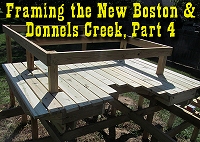 Return to "Framing the NEW New Boston and Donnels Creek RR, Part 4" - Planning and running the decking for the top layer, testing the track plan, checking clearances, prepping used track with new railjoiners, examining the vinyl I ordered to go over the decking, and more. Return to "Framing the NEW New Boston and Donnels Creek RR, Part 4" - Planning and running the decking for the top layer, testing the track plan, checking clearances, prepping used track with new railjoiners, examining the vinyl I ordered to go over the decking, and more.
Click on the photo to see our status as of September 26, 2017
 Return to "Framing the NEW New Boston and Donnels Creek RR, Part 3" -
Getting the frame finished on the top layer, ordering other things I'd need eventually, deciding on materials for the decking on the top layer (at least). Return to "Framing the NEW New Boston and Donnels Creek RR, Part 3" -
Getting the frame finished on the top layer, ordering other things I'd need eventually, deciding on materials for the decking on the top layer (at least).
Click on the photo to see our status as of September 17, 2017
 Return to "Framing the NEW New Boston and Donnels Creek RR, Part 2" -
Once I had the overall frame relatively solid, I hooked up the underground power lines to two GFI plugs that should be in easy reach once everything is finished. I also decided to frame out the top railroad layer while I could still access the center of the railroad easily. Because I was running out of vertical space, I reconfigured that layer. Then after I got the "core" pieces on, I changed my plan again. But the whole thing is getting easier and easier to visualize, and is getting closer to complete with every board I cut and fasten on. Return to "Framing the NEW New Boston and Donnels Creek RR, Part 2" -
Once I had the overall frame relatively solid, I hooked up the underground power lines to two GFI plugs that should be in easy reach once everything is finished. I also decided to frame out the top railroad layer while I could still access the center of the railroad easily. Because I was running out of vertical space, I reconfigured that layer. Then after I got the "core" pieces on, I changed my plan again. But the whole thing is getting easier and easier to visualize, and is getting closer to complete with every board I cut and fasten on.
Click on the photo to see our status as of September 7, 2017
 Return to "Framing the NEW New Boston and Donnels Creek RR, Part 1" -
Once I started dropping posts in the holes and screwing things together, I didn't want to stop before I had the basic frame built (for one thing, the wood warps less once it's fastened in place). Now the folks driving down the street past our house (we're on a corner lot) probably wonder if I'm building an elaborate chicken coop, but that's fine with me. I still need to make a few more lumber runs and do a lot more cutting and sawing, but having the basic frame in place should make the next bits a lot easier. Return to "Framing the NEW New Boston and Donnels Creek RR, Part 1" -
Once I started dropping posts in the holes and screwing things together, I didn't want to stop before I had the basic frame built (for one thing, the wood warps less once it's fastened in place). Now the folks driving down the street past our house (we're on a corner lot) probably wonder if I'm building an elaborate chicken coop, but that's fine with me. I still need to make a few more lumber runs and do a lot more cutting and sawing, but having the basic frame in place should make the next bits a lot easier.
Click on the photo to see our status as of August 10, 2017
 Return to "Breaking Ground on the NEW New Boston and Donnels Creek" -
Okay, in case you wondered if we'd ever get started on the thing, we broke ground in July, using a manual post-hole digger. Well two manual post-hole diggers. But by the end of this article, we're ready for the posts to start going in. Return to "Breaking Ground on the NEW New Boston and Donnels Creek" -
Okay, in case you wondered if we'd ever get started on the thing, we broke ground in July, using a manual post-hole digger. Well two manual post-hole diggers. But by the end of this article, we're ready for the posts to start going in.
Click on the photo to see our status as of the end of July, 2017
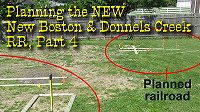 Return to "Planning the NEW New Boston and Donnels Creek, Part 4" -
Well, the rented post-hole digger fell through, so we dug our vegetable garden with a manual post-hole digger (the scissors kind). In addition, I stake out where the railroad was going to be. Twice. And tweaked the plans again. Sorry about the redo's, but sometimes just walking around the yard trying to visualize things makes me reconsider something that seemed "settled" only a few days before. Return to "Planning the NEW New Boston and Donnels Creek, Part 4" -
Well, the rented post-hole digger fell through, so we dug our vegetable garden with a manual post-hole digger (the scissors kind). In addition, I stake out where the railroad was going to be. Twice. And tweaked the plans again. Sorry about the redo's, but sometimes just walking around the yard trying to visualize things makes me reconsider something that seemed "settled" only a few days before.
Click on the photo to see what we were considering as of late May, 2017
 Return to "Planning the NEW New Boston and Donnels Creek, Part 3" -
We have still not broken ground. In part because we plan to rent a post-hole digger and dig the post holes for our raised vegetable garden and the first phase of the garden railroad at the same time, and we don't have enough lumber on hand yet. (If we didn't break it down into multiple trips, we'd be blowing out the shocks on our minivan.) In the meantime, we used a line level to see if the slope of the back yard was as bad as we thought it was (it's worse), and we did other site preparation, including planting a whole bunch of spruce tree seedlings to eventually give us some privacy in our side and back yard. Plus, I'm still wavering a little on the "where-to-start-first" issue. Return to "Planning the NEW New Boston and Donnels Creek, Part 3" -
We have still not broken ground. In part because we plan to rent a post-hole digger and dig the post holes for our raised vegetable garden and the first phase of the garden railroad at the same time, and we don't have enough lumber on hand yet. (If we didn't break it down into multiple trips, we'd be blowing out the shocks on our minivan.) In the meantime, we used a line level to see if the slope of the back yard was as bad as we thought it was (it's worse), and we did other site preparation, including planting a whole bunch of spruce tree seedlings to eventually give us some privacy in our side and back yard. Plus, I'm still wavering a little on the "where-to-start-first" issue.
Click on the photo to see what we were considering as of late April, 2017
 Return to "Planning the NEW New Boston and Donnels Creek, Part 2" -
More plans. We've moved on from the 2"x6" roadbed-on-posts to a sort of "train-table-outside" plan. Our goals include low-maintenance, high interest, and high reliability. We're also trying to get around having a thousand dollars' worth of dirt hauled into the back yard. If you want to get some idea of what our planning process looks like, reading these through in sequence may help. Or it may drive you crazy. Return to "Planning the NEW New Boston and Donnels Creek, Part 2" -
More plans. We've moved on from the 2"x6" roadbed-on-posts to a sort of "train-table-outside" plan. Our goals include low-maintenance, high interest, and high reliability. We're also trying to get around having a thousand dollars' worth of dirt hauled into the back yard. If you want to get some idea of what our planning process looks like, reading these through in sequence may help. Or it may drive you crazy.
Click on the photo to see what we were considering in early April, 2017
 Return to "Planning the NEW New Boston and Donnels Creek, Part 1" -
If you're subscribed to our newsletter, you know that we moved just after Thanksgiving in 2016, leaving behind most of the track, a few of the bird feeders, and one Bachmann train set for the new owners. We also left behind a high-maintenance garden that we do not intend to replicate at the new place. This is the first chapter of a new chapter in our lives, which we hope will include a lot of "lessons learned." But first, some serious landscaping had to take place. Return to "Planning the NEW New Boston and Donnels Creek, Part 1" -
If you're subscribed to our newsletter, you know that we moved just after Thanksgiving in 2016, leaving behind most of the track, a few of the bird feeders, and one Bachmann train set for the new owners. We also left behind a high-maintenance garden that we do not intend to replicate at the new place. This is the first chapter of a new chapter in our lives, which we hope will include a lot of "lessons learned." But first, some serious landscaping had to take place.
Click on the photo to see what we were considering in March, 2017
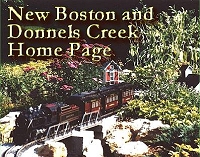 Return to the New Boston and Donnels Creek RR Page - This is the page describing Paul Race's progress and frequent rework on his own garden railroad, started on a shoe-string budget in 1998, later expanded, and later refurbished several times as issues arose. Issues that Paul hopes to avoid by building the next iteration above ground. Return to the New Boston and Donnels Creek RR Page - This is the page describing Paul Race's progress and frequent rework on his own garden railroad, started on a shoe-string budget in 1998, later expanded, and later refurbished several times as issues arose. Issues that Paul hopes to avoid by building the next iteration above ground.
Click on the photo to see the home page of Paul's railroad.
 Return to Family Garden Trains' Home Page - The home page with links to all the other stuff, including design guidelines, construction techniques, structure tips, free graphics, and more. Return to Family Garden Trains' Home Page - The home page with links to all the other stuff, including design guidelines, construction techniques, structure tips, free graphics, and more.
To read more, or to look at recommended Garden Railroading and Big Indoor Train products, please click on the index pages below.
| 
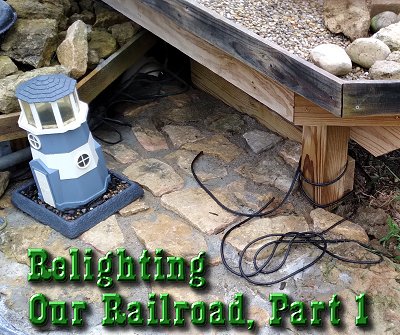













 The photo to the right shows a simplified version of my current plan, already mostly achieved. (No, I won't show a photo, since there's still some cleaning up to do.)
The photo to the right shows a simplified version of my current plan, already mostly achieved. (No, I won't show a photo, since there's still some cleaning up to do.)
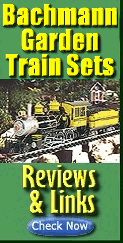



















































 Penn Plax" air pump
Penn Plax" air pump Proceed to "Relighting Our Railroad, Part 2"
Proceed to "Relighting Our Railroad, Part 2" Return to "Pondscaping, Part 2"
Return to "Pondscaping, Part 2" Return to "Pondscaping, Part 1"
Return to "Pondscaping, Part 1" Return to "Easy Lighting for North States Bird Feeders"
Return to "Easy Lighting for North States Bird Feeders" Return to "Preparing for 2021's Christmas Train Day."
Return to "Preparing for 2021's Christmas Train Day." Return to "Making a Large Scale Ghost Train"
Return to "Making a Large Scale Ghost Train" Return to "Portal Installation on the New Boston and Donnels Creek."
Return to "Portal Installation on the New Boston and Donnels Creek."  Return to "Dirtscaping on the New Boston and Donnels Creek, Part 3"
Return to "Dirtscaping on the New Boston and Donnels Creek, Part 3" Return to "Tunnel Framing on the New Boston and Donnels Creek, Part 2"
Return to "Tunnel Framing on the New Boston and Donnels Creek, Part 2" Return to "Tunnel Framing on the New Boston and Donnels Creek, Part 1."
Return to "Tunnel Framing on the New Boston and Donnels Creek, Part 1."  Return to "New Right-of-Ways on the New Boston and Donnels Creek RR"
Return to "New Right-of-Ways on the New Boston and Donnels Creek RR" Return to "Creating a Railroad Timetable"
Return to "Creating a Railroad Timetable" Return to "Christmas Preparations and Operations 2020"
Return to "Christmas Preparations and Operations 2020" Return to "Garage to Train Station, Part 2"
Return to "Garage to Train Station, Part 2" Return to "Garage to Train Station, Part 1"
Return to "Garage to Train Station, Part 1" Return to "Westward Expansion, 2020, Part 3"
Return to "Westward Expansion, 2020, Part 3" Return to "Westward Expansion, 2020, Part 2"
Return to "Westward Expansion, 2020, Part 2" Return to "Westward Expansion, 2020, Part 1"
Return to "Westward Expansion, 2020, Part 1" Return to "Train Storage Solutions, 2020"
Return to "Train Storage Solutions, 2020" Return to "Expansion Planning, 2020"
Return to "Expansion Planning, 2020" Return to "Winter Preparation, 2019"
Return to "Winter Preparation, 2019" Return to "Christmas Train Day, 2019"
Return to "Christmas Train Day, 2019" Return to "Preparing for Christmas Train Day 2019"
Return to "Preparing for Christmas Train Day 2019" Return to Decking the NEW New Boston and Donnels Creek Part 2
Return to Decking the NEW New Boston and Donnels Creek Part 2 Return to "Framing the NEW New Boston and Donnels Creek RR - Part 7"
Return to "Framing the NEW New Boston and Donnels Creek RR - Part 7" Return to "Planning the NEW New Boston and Donnels Creek RR - Part 5"
Return to "Planning the NEW New Boston and Donnels Creek RR - Part 5" Return to Waterscaping Part 4.
Return to Waterscaping Part 4. Return to "Waterscaping, Part 3"
Return to "Waterscaping, Part 3" Return to Christmas Train Day, 2018
Return to Christmas Train Day, 2018 Return to "Adding a Train Shed Part 6"
Return to "Adding a Train Shed Part 6" Return to "Adding a Train Shed Part 5"
Return to "Adding a Train Shed Part 5" Return to "Adding a Train Shed Part 4"
Return to "Adding a Train Shed Part 4" Return to "Adding a Train Shed Part 3"
Return to "Adding a Train Shed Part 3" Return to "Waterscaping Part 2"
Return to "Waterscaping Part 2" Return to "Adding a Train Shed Part 2"
Return to "Adding a Train Shed Part 2" Return to "Adding a Train Shed Part 1"
Return to "Adding a Train Shed Part 1" Return to "Waterscaping the NEW New Boston and Donnels Creek Part 1,"
Return to "Waterscaping the NEW New Boston and Donnels Creek Part 1,"  Return to "Dirtscaping the NEW New Boston and Donnels Creek RR, Part 2.
Return to "Dirtscaping the NEW New Boston and Donnels Creek RR, Part 2. Return to "Adding Raised Roadbed to the NEW New Boston and Donnels Creek, Part 2"
Return to "Adding Raised Roadbed to the NEW New Boston and Donnels Creek, Part 2" Return to "Adding Raised Roadbed to the NEW New Boston and Donnels Creek RR, Part 1"
Return to "Adding Raised Roadbed to the NEW New Boston and Donnels Creek RR, Part 1" Return to "2018: Springing into Spring on the NEW New Boston & Donnels Creek RR."
Return to "2018: Springing into Spring on the NEW New Boston & Donnels Creek RR." Return to "Dirtscaping the NEW New Boston and Donnels Creek RR, Part 1.
Return to "Dirtscaping the NEW New Boston and Donnels Creek RR, Part 1. Return to "Decking the NEW New Boston and Donnels Creek RR
Return to "Decking the NEW New Boston and Donnels Creek RR Return to "Framing the NEW New Boston and Donnels Creek RR, Part 6"
Return to "Framing the NEW New Boston and Donnels Creek RR, Part 6" Return to "Framing the NEW New Boston and Donnels Creek RR, Part 5"
Return to "Framing the NEW New Boston and Donnels Creek RR, Part 5" Return to "Framing the NEW New Boston and Donnels Creek RR, Part 4"
Return to "Framing the NEW New Boston and Donnels Creek RR, Part 4" Return to "Framing the NEW New Boston and Donnels Creek RR, Part 3"
Return to "Framing the NEW New Boston and Donnels Creek RR, Part 3" Return to "Framing the NEW New Boston and Donnels Creek RR, Part 2"
Return to "Framing the NEW New Boston and Donnels Creek RR, Part 2" Return to "Framing the NEW New Boston and Donnels Creek RR, Part 1"
Return to "Framing the NEW New Boston and Donnels Creek RR, Part 1" Return to "Breaking Ground on the NEW New Boston and Donnels Creek"
Return to "Breaking Ground on the NEW New Boston and Donnels Creek" Return to "Planning the NEW New Boston and Donnels Creek, Part 4"
Return to "Planning the NEW New Boston and Donnels Creek, Part 4" Return to "Planning the NEW New Boston and Donnels Creek, Part 3"
Return to "Planning the NEW New Boston and Donnels Creek, Part 3" Return to "Planning the NEW New Boston and Donnels Creek, Part 2"
Return to "Planning the NEW New Boston and Donnels Creek, Part 2" Return to "Planning the NEW New Boston and Donnels Creek, Part 1"
Return to "Planning the NEW New Boston and Donnels Creek, Part 1" Return to the New Boston and Donnels Creek RR Page
Return to the New Boston and Donnels Creek RR Page Return to Family Garden Trains' Home Page
Return to Family Garden Trains' Home Page